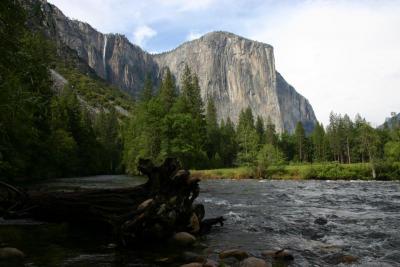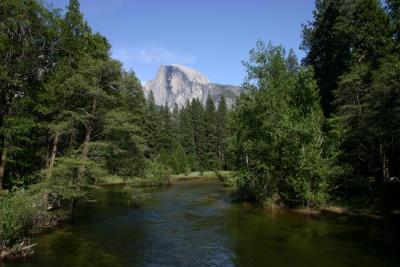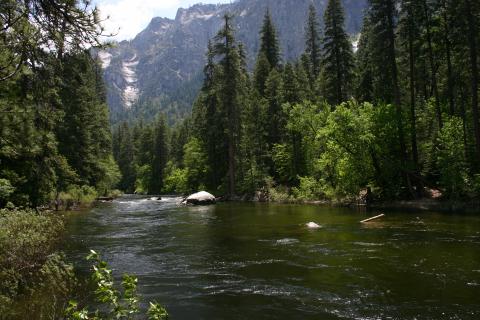(photos by author)
 In May of 1909, John Burroughs visited Yosemite Valley as the guest of John Muir. One hundred years later, in May of 2009, I photographed many of the landmarks that Burroughs saw during his brief stay in the valley.
In May of 1909, John Burroughs visited Yosemite Valley as the guest of John Muir. One hundred years later, in May of 2009, I photographed many of the landmarks that Burroughs saw during his brief stay in the valley.
In his essay “The Spell of the Yosemite,” Burroughs writes,“Yosemite won my heart at once, as it seems to win the hearts of all who visit it.” Indeed, he rejoices in “the whole character of the scene, not only its beauty and sublimity, but the air of peace and protection, and of homelike seclusion that pervades it; the charm of a nook, a retreat, combined with the power and grandeur of nature in her sternest moods.”
Burroughs then recounts his entrance into Yosemite Valley: “After passing from the hotel at El Portal along the foaming and roaring Merced River, and amid the tumbled confusion of enormous granite boulders shaken down from the cliffs above (see photo 1), you cross the threshold of the great valley as into some vast house or hall carved out of the mountains, and at once feel the spell of the brooding calm and sheltered seclusion that pervades it. You pass suddenly from the tumultuous, the chaotic, into the ordered, the tranquil, the restful, which seems enhanced by the power and grandeur that encompass them about. (see photo 2) You can hardly be prepared for the hush that suddenly falls upon the river and for the gentle rural and sylvan character of much that surrounds you; the peace of the fields, the seclusion of the woods, the privacy of sunny glades, the enchantment of falls and lucid waters, with a touch of human occupancy here and there—all this, set in that enormous granite frame, three or four thousand feet high, ornamented with domes and spires and peaks still higher—it is all this that wins your heart and fills your imagination in the Yosemite.”

Next, he describes the scenic wonders that make the valley one of the most remarkable places in the world: “El Capitan stands there showing its simple sweeping lines through the trees as you approach, like one of the veritable pillars of the firmament. How long we are nearing it and passing it! It is so colossal that it seems near while it is yet far off. It is so simple that the eye takes in its naked grandeur at a glance. It demands of you a new standard of size which you cannot at once produce. It is as clean and smooth as the flank of a horse, and as poised and calm as a Greek statue. It curves out toward the base as if planted there to resist the pressure of worlds—probably the most majestic single granite column or mountain buttress on the earth. Its summit is over three thousand feet above you. (see photo 3)
“Across the valley, nearly opposite, rise the Cathedral Rocks to nearly the same height. . . . . Near the head of the great valley North Dome, perfect in outline as if turned in a lathe, and its brother, the Half Dome (or shall we say half-brother?) across the valley (see photo 4), look down upon Mirror Lake from an altitude of over four thousand feet.”
At one point, Burroughs witnesses Yosemite Falls in the full flush of its spring flow: “The first leap of Yosemite Falls is sixteen hundred feet—sixteen hundred feet of a compact mass of snowy rockets shooting downward and bursting into spray around which rainbows flit and hover.” Indeed, he says, “It is the waterfalls that make the granite alive, and burst into bloom as it were. What a touch they give! How they enliven the scene! What music they evoke from these harps of stone!”
Finally, Burroughs discusses the eroding power of glacial ice and water that created Yosemite Valley, and he makes this observation:
 “Guided by one’s ordinary sense or judgment alone, one’s judgment as developed and disciplined by the everyday affairs of life and the everyday course of nature, one would say on beholding Yosemite that here is the work of exceptional and extraordinary agents or world-building forces. It is as surprising and exceptional as would be a cathedral in a village street, or a gigantic sequoia in a grove of our balsam firs. The approach to it up the Merced River does not prepare one for any such astonishing spectacle as awaits one. The rushing, foaming water amid the tumbled confusion of huge granite rocks and the open V-shaped valley, are nothing very remarkable or unusual. Then suddenly you are on the threshold of this hall of the elder gods. Demons and furies might lurk in the valley below, but here is the abode of the serene, beneficent Olympian deities. All is so calm, so hushed, so friendly, yet so towering, so stupendous, so unspeakably beautiful. You are in a mansion carved out of the granite foundations of the earth, with walls two or three thousand feet high, hung here and there with snow-white waterfalls, and supporting the blue sky on domes and pinnacles still higher. Oh, the calmness and majesty of the scene! the evidence of such tremendous activity of some force, some agent, and now so tranquil, so sheltering, so beneficent!”
“Guided by one’s ordinary sense or judgment alone, one’s judgment as developed and disciplined by the everyday affairs of life and the everyday course of nature, one would say on beholding Yosemite that here is the work of exceptional and extraordinary agents or world-building forces. It is as surprising and exceptional as would be a cathedral in a village street, or a gigantic sequoia in a grove of our balsam firs. The approach to it up the Merced River does not prepare one for any such astonishing spectacle as awaits one. The rushing, foaming water amid the tumbled confusion of huge granite rocks and the open V-shaped valley, are nothing very remarkable or unusual. Then suddenly you are on the threshold of this hall of the elder gods. Demons and furies might lurk in the valley below, but here is the abode of the serene, beneficent Olympian deities. All is so calm, so hushed, so friendly, yet so towering, so stupendous, so unspeakably beautiful. You are in a mansion carved out of the granite foundations of the earth, with walls two or three thousand feet high, hung here and there with snow-white waterfalls, and supporting the blue sky on domes and pinnacles still higher. Oh, the calmness and majesty of the scene! the evidence of such tremendous activity of some force, some agent, and now so tranquil, so sheltering, so beneficent!”
This, then, is the essence of Yosemite. As Burroughs so eloquently puts it, “For quiet majesty and beauty, with a touch of sylvan and pastoral too, Yosemite stands alone. One could live with Yosemite, camp in it, tramp in it, winter and summer in it, and find nature in her tender and human, almost domestic moods, as well as in her grand and austere.”



